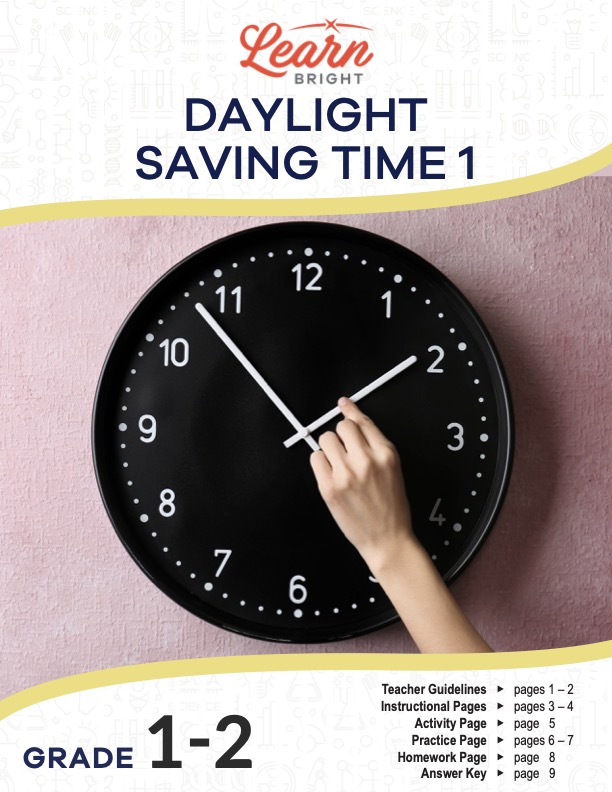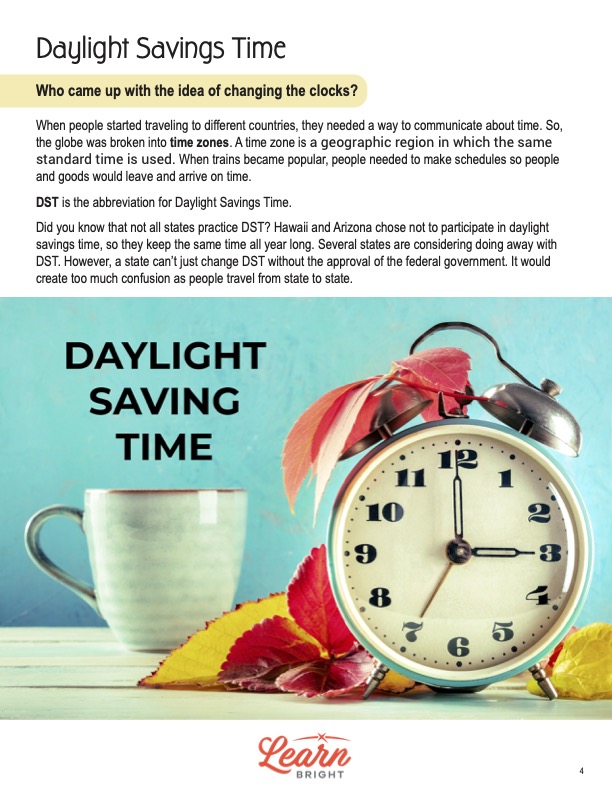Description
What our Daylight Saving Time 1 lesson plan includes
Lesson Objectives and Overview: Daylight Saving Time 1 introduces students to the origins of DST and why people still use it today. Students will learn that some places do not choose to use DST. They will also learn how to adjust clocks. This lesson is for students in 1st grade and 2nd grade.
Classroom Procedure
Every lesson plan provides you with a classroom procedure page that outlines a step-by-step guide to follow. You do not have to follow the guide exactly. The guide helps you organize the lesson and details when to hand out worksheets. It also lists information in the yellow box that you might find useful. You will find the lesson objectives, state standards, and number of class sessions the lesson should take to complete in this area. In addition, it describes the supplies you will need as well as what and how you need to prepare beforehand. For this lesson, you will need pencils, pens, and highlighters.
Options for Lesson
You can check out the “Options for Lesson” section of the classroom procedure page for additional suggestions for ideas and activities to incorporate into the lesson. One idea is to show students a world map of time zones and explain why it is important to know what time zone a person is located in. Another option is to explain how electricity has changed the need for daylight saving time. One more option is to have students investigate which countries also use DST besides the United States.
Teacher Notes
The paragraph on this page provides a little more information or guidance on what to expect from the lesson. You can use the blank lines to record any thoughts or ideas you have as you prepare.
DAYLIGHT SAVING TIME 1 LESSON PLAN CONTENT PAGES
What Is Daylight Saving Time?
The Daylight Saving Time 1 lesson plan has two pages of content. The lesson starts off by asking why we change the time on the clocks twice a year. It can be confusing sometimes when people say we lose an hour or gain an hour on those days. If there are only 24 hours in a day, how can we lose or gain one?
We turn the clocks forward an hour in the spring. And in the fall or winter, we set them back an hour. Students will discover that as the Earth rotates during the year, the amount of sunlight different locations get changes. Daylight saving time (DST) is a way to use the daylight better. We set the clocks an hour ahead when there is less sunlight in the morning and more sunlight in the evening. We set them back when there is more light in the morning and less in the evening.
Each year, the clocks move forward an hour on the second Sunday in the month of March. They move back an hour on the first Sunday in November.
Origin of DST
The second content page describes the history behind Daylight Saving Time. When people started traveling to other countries, they needed a way to communicate about time. The globe was divided into time zones, which is a geographic region in which people use the same standard time. When trains became popular, we needed to make schedules so people and goods would leave and arrive on time.
Not all states (or other places in the world) practice DST. Hawaii and Arizona chose not to participate in daylight saving time and instead keep the same time all year long. In addition, several states are considering doing away with DST. However, a state can’t just change whether or not they practice it without approval from the federal government. It would create too much confusion as people travel from state to state.
DAYLIGHT SAVING TIME 1 LESSON PLAN WORKSHEETS
The Daylight Saving Time 1 lesson plan includes three worksheets: an activity worksheet, a practice worksheet, and a homework assignment. Each one will reinforce students’ comprehension of lesson material in different ways and help them demonstrate when they learned. Use the guidelines on the classroom procedure page to determine when to distribute each worksheet to the class.
AN EXTRA HOUR ACTIVITY WORKSHEET
What would you do with an extra hour of time? For the activity, students will ponder this question and write three sentences about how they would choose to spend that extra hour. Then they will draw a picture in the box on the worksheet that represents their response.
WHAT TIME IS IT? PRACTICE WORKSHEET
The practice worksheet lists 10 clocks. For the first five, students will imagine it’s the second Sunday in March and the clocks need to move forward an hour. They must change the time on the clocks by writing the new time on the line below each clock. Then they will imagine it’s the first Sunday in November and the clocks must push back an hour. Again, they will write the new time below each clock.
DAYLIGHT SAVING TIME 1 HOMEWORK ASSIGNMENT
For the homework assignment, students will review a time zone map. It shows the names of each of the U.S. time zones and what time it is in those zones. Students will use this information to respond to a series of seven questions.
Worksheet Answer Keys
If you choose to administer the lesson pages to your students via PDF, you will need to save a new file that omits these pages. Otherwise, you can simply print out the applicable pages and keep these as reference for yourself when grading assignments.









